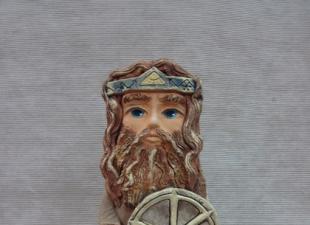Or fluffy - deciduous tree up to 20 m tall and up to 60 cm in diameter of the trunk. The leaves are simple, whole, (4-8) x (3-6) cm.
Naturally grows in the vast territory of Eurasia.
In Novosibirsk: a tree at 10 years old is 2,0-4,0 m tall, at 15 years old - 5.5-7.5 m, at 20 years old - 7.5-10.5 m, at 27 years old - 13.0 m. Fruits in the second half of August.
In urban landings is very rare. Everywhere abundantly fruiting. Seeds spill out in the fall and in the first half of winter.
Winter hardiness 1. The fast-growing tree, which requires more moist and rich soil than the widespread in the city hanging birch, or warty. Non-durable, gas-resistant, relatively light-requiring. Well tolerates excessive soil moisture.
It is propagated only by seeds, which are best sown in the fall under the snow. For spring siftings, a preliminary cold stratification within 1-2 months is desirable.
Very decorative due to the pure white color of the bark, especially at a young age. Durability in urban environments 100-150 years. In 1995, I.Yu. Koropachinsky was brought from Finland form with purple leaves, which began to multiply successfully in the arboretum CSBG. In the conditions of Novosibirsk, it is characterized by high stability and rapid growth, which suggests the need for its wider reproduction and introduction into the greening of the city.
Recommended for widespread use in the creation of large arrays, landscape groups and in the alleys plantings.
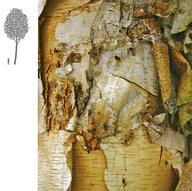 (Betula papyrifera)
(Betula papyrifera)
Height: up to 24 m
Type of: deciduous tree shedding leaves for the winter
Area: northern regions of the United States (including Alaska) and Canada
Places of growth: Deciduous and coniferous forests of the temperate zone, margin of marshes, river valleys
- one of the most northern species of American birch - became famous for its beautiful white bark (bark), from which the North American Indians built canoes, roofs for their homes and even dishes. In winter, the branches of this tree are the main food of elk.
The bark of birch trees is formed by layers. In old birch trees, it sometimes cracks and peels off with thin ribbons. The birch bark contains a water repellent substance, suberin, which makes it waterproof.
![]() , or black - deciduous tree 12-25 m tall. The leaves are simple, whole, (3-9) x (1-6) cm. Naturally grows in Eastern Siberia, in the Far East, in overseas Asia.
, or black - deciduous tree 12-25 m tall. The leaves are simple, whole, (3-9) x (1-6) cm. Naturally grows in Eastern Siberia, in the Far East, in overseas Asia.
In Novosibirsk (CSBG): a tree at 15 years old 2.7 (3.1) m tall, at 23 years old - 10.5 m, at 35 years old - 14 m. Winter hardiness 1. Prefers relatively moist rich soils, is not drought resistant. Light-requiring Gas resistant.
It has a special decorative effect due to the original color of the bark. On young stems, the color of the bark varies from yellowish-brown to reddish; with age, the bark on the trunks becomes dark gray, black-brown, sometimes almost black, cracks strongly and flakes off.
Propagated by seeds, which should be collected in late summer - early autumn, when the earrings become yellow-brown in color and crumble when bent. It is possible to use all the dates of sowing: summer, autumn, winter and spring. For spring sowing, it is recommended to carry out stratification mixed with wet sand at a temperature of 1-5 ° C for 1-1.5 months.
Durability 80-100 years.
Recommended for widespread use in single and group plantings, alleys.
Disadvantage: like other types of birch, due to the large amount of pollen, it is capable of causing pollinosis during the flowering period.
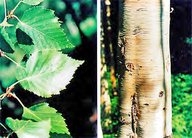 , or Erman - A tree up to 20 m tall in natural conditions, with a twisted trunk, sometimes a shrub. In Novosibirsk (CSBG) at the age of about 20 years, retains straight trunks, which is not typical for this species. The bark of the trunks is dark gray, yellowish-brown, flaking. The leaves are simple, whole, (3-10) x (2-6) cm, from elliptical to ovate, naked above, dark green, often pubescent below. Branches are brown or reddish-brown, covered with lentils.
, or Erman - A tree up to 20 m tall in natural conditions, with a twisted trunk, sometimes a shrub. In Novosibirsk (CSBG) at the age of about 20 years, retains straight trunks, which is not typical for this species. The bark of the trunks is dark gray, yellowish-brown, flaking. The leaves are simple, whole, (3-10) x (2-6) cm, from elliptical to ovate, naked above, dark green, often pubescent below. Branches are brown or reddish-brown, covered with lentils.
Natural area: Kamchatka, Eastern Siberia, east of Lake Baikal. It grows high in the mountains, often forming the upper boundary of the forest.
Winter hardiness 1. Growth is slow. Non-durable, light-requiring. Can grow on relatively poor rocky soils. Fruits in open, lighted places from 7-8 years. Seeds ripen in the second half of August, and spill out during the autumn and first half of winter.
It is propagated only by seeds, which are desirable to be sown in the fall under the snow. For spring sowing, a preliminary cold stratification is necessary for 2-3 months.
It can be recommended for creating small landscape groups on lawns. Of particular interest is the landscaping of steep slopes with stony soils. It can be used as a decorative low tree, which has an unusual crown shape and bark color.
On the territory of Eastern Siberia is allocated as an independent species. Betula lanata, differing from a stone birch only by dense pubescence of young shoots and leaves. Its biological features and recommendations for reproduction and use in landscaping are the same.
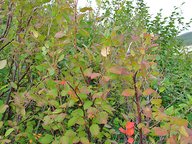 - deciduous shrub 1-4 m tall or small tree. The leaves are simple, whole, (1.0-5.0) x (0.8-3.5) cm, from ovate to elliptical. Grows in Eurasia.
- deciduous shrub 1-4 m tall or small tree. The leaves are simple, whole, (1.0-5.0) x (0.8-3.5) cm, from ovate to elliptical. Grows in Eurasia.
In Novosibirsk: shrub at 10 years old 2.5-3.0 m tall, at 15-20 years old - 3.2-4.1 m. Vegetation from May 10-15 until the end of August. The leaves fall in the second half of September. It blooms from the second decade of May for 5-8 days. Fruits in 5 years from the second half of August, regularly, abundantly. The leaves are yellow-brown in autumn. Winter hardiness 1. Prefers drained, wetted habitats. It grows better on carbonate soils. Light-requiring, drought-resistant. Durability about 20 years.
It is recommended in single and group plantings, when creating alpine slides (especially undersized small-leaved forms).
Leaves are sometimes damaged by pests. It is propagated only by seeds that need to be stratified beforehand, although they are able to germinate without stratification, however, their germination and germination energy are reduced.
It can be recommended for creating group plantings on wet, relatively rich soils, on well-lit places, especially along the banks of water bodies.
 - deciduous tree 4-18 m tall. The leaves are simple, whole, often dark green (1.5-5.5) x (0.8-4.5) cm, from rhombic to obovate.
- deciduous tree 4-18 m tall. The leaves are simple, whole, often dark green (1.5-5.5) x (0.8-4.5) cm, from rhombic to obovate.
Naturally grows in Tuva, Mongolia, Central Asia, in the South-Eastern Altai.
Fruits in 6-9 years. Winter hardiness 1. Drought-resistant, heat-resistant, undemanding to soils. Light-requiring Gas resistant. Particularly decorative small foliage, yellowing in autumn, and yellow-gray, beige, sometimes almost white, exfoliated bark of the trunks. Durability about 40 years. It is recommended for wide use in single and group plantings, avenues, arrays.
Disadvantages: the leaves are sometimes damaged by pests and fungal diseases; by the age of 30, sushi accumulate inside the crowns and the decorative effect decreases somewhat.
It is propagated only by seeds, which in spring sowing should preferably be stratified for 1.5-2 months at a temperature of 3-5 ° С.
7
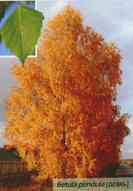
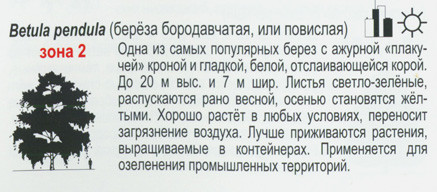
Distributed throughout the European part of Russia and beyond the Urals to the Ob River. One of the most popular birch trees, without which gardening does not do in Russia. In Novosibirsk: a tree at 10 years old is 3-4 m tall, at 21 years old - 9-10 m, at 50 years old - 16 m. Fruits from 5-6 years. Winter hardiness 1.
It is undemanding to the wealth and moisture of the soil, drought-resistant. Light-requiring Gas resistant.
Particularly decorative due to the white bark and autumn yellow color of the leaves. Durability of 150-250 years. Recommended for widespread use in landscaping and protective afforestation.
It is propagated only by seeds, which in spring sowing must be stratified for 1.5-2 months at low temperatures (2-5 ° C).
The buds are conical, bare (without pubescence), covered with tiles arranged closely, tightly pressed along the edges, slightly ciliated scales 3–7 mm long, 1.5–3 mm in diameter. The color of the buds is brown, brown, sometimes greenish at the base; balsamic odor, aggravated by rubbing; taste is slightly astringent, resinous.
Birch buds contain up to 5% of essential oil, flavonoids, vitamins, tannins.
In folk medicine, the kidneys and leaves have been widely used to regulate the activity of the gastrointestinal tract, in diseases of the liver and bladder, rheumatism, and gout. Birch tar obtained from bark was used for rheumatism, liver diseases, and in veterinary medicine, for the treatment of wounds and for purulent diseases, for colic, as anthelmintic. Birch sap - known as tonic, stimulant, used for the manufacture of kvass, syrup, vinegar.
Currently, birch buds are used in the form of decoctions as a disinfectant, diuretic, choleretic agent, due to the content of flavonoids and essential oil. Of practical importance is also birch tar, which is part of the ointments used to treat wounds and skin diseases. Activated birch charcoal is used in the form of tablets as an adsorbent for poisoning, food intoxication, and meteorism. The fertile catkins, drooping, cylindrical in shape, 5-7 cm long, 9-12 mm in diameter, are arranged in brushes of 3-4 pieces. Bracts in rhombic shape, three-blade with three prominent veins; the blades at the ends are rounded, the middle is longer than the lateral upward directed., or himalayan (Betula utilis)
The whitest birch grows not in Europe, not in Siberia, or even in America. In the skies of the Eastern Himalayas, next to the glaciers of the highest peaks of the planet, above the border of rhododendron thickets and coniferous forests, birch trees grow with such white trunks, that without leaves they look like wind-bones of giants. This birch is useful, and it justifies its name: at an altitude of more than 4500 m above sea level, there are practically no other large trees, and it is this single species that provides the Nepalese and Bhutanese mountain dwellers with fuel and building material.
Himalayan birch is strikingly beautiful with its huge leaves - they reach the size of a human palm, and in autumn they turn bright yellow and hold on the branches for quite a long time. Unfortunately, this birch is rarely available for sale, with the possible exception of the variety "Doorenbos" obtained in the Dutch nursery of the same name. Unlike the natural species, which is characterized in general by a straight trunk, "Doorenbos" is more like a Karelian birch - when grown, it is not a single-stem tree, but a huge shrub. The useful birch grows surprisingly fast (the growth of a five to six year old plant can reach one and a half meters per year and is completely winter-hardy at the latitude of Moscow, which, of course, makes its distribution in gardens very desirable.
.
Citrus hybrids: varieties.
Oranges: varieties for the home.
Grapefruits: varieties for the home.
Gardeners gardeners
website, 2000-2017 - an online resource about home and family. About indoor plants, landscape design, soap making, permaculture, natural agriculture, about gardens, growing plants and flowers, about natural gemstones, high-quality home goods, good books. Personal experience of people living outside the city, reviews and recommendations.
June 23, 2007
Birch - the tree of life
For a long time, birch has been especially honored and respected in Russia. This is due not only to the fact that the white-trunked forest beauty has become a kind of symbol of spring, light, love for the motherland, but also with its numerous healing properties. It is not by chance that birch is called the tree of life and health.
BIRCH grows in many countries. In Russia, birch groves occupy the third place in terms of their distribution after pine and deciduous forests.
Few people know that besides the traditional white color of birch bark, it can be yellow, pink, and bright orange, and dark purple, and black.
In general, there are about 120 species of birch, 64 of which are found in Russia. The life span of a tree does not exceed 120 years, with the exception of the so-called iron birch, which sometimes falls short of 400 years.
Practically everything that a birch can give — bark, buds, leaves, birch sap, and even birch fungus (chaga) in the form of ugly growths on the trunk — finds application in traditional medicine.
Birch buds can be collected from January, but young buds have the strongest effect on the body. Birch buds are usually harvested in March-April, when they have already swelled, but have not yet begun to grow.
Birch buds contain essential oil, ascorbic acid, flavonoids, resins, tannins, bitterness, grape sugar. They are used in diseases of the respiratory system (laryngitis, tracheitis, bronchitis) as an antiseptic and expectorant. Birch buds are used as an anti-inflammatory agent, adding to hygienic baths or using lotions and dressings for minor injuries and soft tissue industrial injuries, as well as for bedsores, chronic purulent wounds, trophic ulcers and non-healing wounds.
Birch buds can be used to prepare an infusion that will help organize the work of the gastrointestinal tract, useful for skin diseases, edema caused by renal or heart failure. To do this, take 1 tablespoon of the kidneys, pour 250 ml of cold water over them and insist on a water bath for 20-30 minutes, then cool and strain. Take an infusion of 1 tablespoon 4-6 times a day.
At home, you can make a tincture of birch buds. It will help with spastic states of the stomach, with fatigue and insomnia, facilitate the menopausal period. To do this, you need to pour 15-20 grams of birch buds 0.5 liters of alcohol, insist and take 15-20 drops daily 2-3 times a day. This tincture can be used externally for rubbing and compressing the joints for arthritis and rheumatism.
As an antiemetic, water infusion of birch buds is used. 1 tablespoon of dried buds is poured with a glass of boiling water, infused for 30 minutes, filtered and take 30-50 grams every hour.
In early spring, in late March - early April, the process of rapid sap flow begins. It is very important not to miss this period (it lasts no more than 10 days) and if you do not prepare it for the future, then at least drink plenty of birch sap.
It contains many beneficial substances for the body, vitamins, organic acids, proteins and trace elements.
Birch sap has a rejuvenating effect, stimulates the metabolism, destroys urinary stones mainly of phosphate and carbonate origin, is used as an antihelminthic. It is used for intoxication and cancer.
Birch sap normalizes the acidity of the stomach, has a diuretic effect, helps with gout, arthritis, edema, rheumatism, colds, pneumonia, tuberculosis, helps strengthen the gums. It is recommended to drink it 3-4 times a day before meals for 2-3 weeks, while maintaining a dairy-vegetable diet.
With various skin diseases, birch sap is used externally in the form of lotions. They can wipe damaged skin. In case of hair loss, you should rub birch sap into the skin of the scalp, adding alcohol, brandy or decoction of burdock root.
It is useful to mix birch sap with other juices obtained from fresh fruits and vegetables, as well as insist on St. John's wort, rosehip, mint, thyme, basil, lime blossom, boiling water, lingonberries.
The annual spring course of taking birch sap will help get rid of weakness, fatigue, increased fatigue, irritability, dizziness, noise in the ears, headache, insomnia. You will improve your mood and general condition of the body.
Do not try to confuse natural birch sap, obtained independently, with the "store", which is sold in stores. Magazine is a typical surrogate, a mixture of water, sugar and some citric acid.
In April - May, in sunny dry weather, birch pollen is collected. She has a truly miraculous properties.
By eliminating harmful microbes in the intestines, birch pollen promotes the development of beneficial microorganisms. In addition, it regulates the function of the digestive tract, relieves constipation, helps with exhaustion and infectious diseases.
Especially good birch pollen works in a mixture with natural honey. This is an excellent firming agent with a high content of biologically active substances and vitamins.
Birch pollen is not only a remedy, but also an indispensable food product for health. When you add it to the usual food, there is a feeling of cheerfulness, vitality and satisfaction.
Birch pollen as a therapeutic and prophylactic agent is best taken on an empty stomach or shortly before meals, 20-30 grams per day. The course of treatment is 1 month. It is desirable to repeat it every year.
In May - June, young birch leaves are usually collected. Tea of them is considered one of the best diuretics. Strengthening the formation of urine, it is absolutely not annoying kidneys.
Birch leaves have a powerful bactericidal action. It is necessary to collect them when they are still sticky and fragrant. They are dried in the shade under sheds, in attics or in well ventilated areas.
From young birch leaves prepare water infusions and decoctions. In addition to a pronounced choleretic and diuretic effect, an infusion of young birch leaves is used to calm the nervous system, with headache, dizziness, sleep disorders, migraines, coronary heart disease, atherosclerosis. It is enough to drink it on 2 glasses a day. Such decoctions are used externally for skin diseases, rheumatism of the joints, as well as for washing the head.
The infusion of birch leaves is prepared as follows: 2 tablespoons of crushed leaves should be poured 0.5 liters of boiling water, insist on a water bath for 15 minutes, cool at room temperature, drain, add baking soda at the tip of the knife. Take a decoction of 0.5 cups 3 times a day for 20-30 minutes before meals.
Acceptance of water infusion and extract from birch leaves causes the death of Giardia and Trichomonas.
Good effect is observed as a result of the use of birch infusions and decoctions for diseases of the upper respiratory tract, arthritis, cholelithiasis, in gynecology and dermatovenereology.
Young birch leaves are used in the treatment of childhood rheumatism. In cosmetology, pigment spots are removed with birch broth.
When wood is roasted, birch coal is obtained. The preparation of purified birch coal is used as an adsorbent for flatulence, stomach cramps, increased acidity of gastric juice, and various poisonings.
In case of burns, it is necessary to pour birch coal crushed into powder on the wound, which contributes to its rapid healing.
And this is not a complete list of diseases that birch treats. Will there be at least one chemical pill that would have the same broad spectrum of action and at the same time still not have any side effects on the body? Hardly.
For the treatment of alcoholism, traditional medicine recommends this method. Dry birch firewood is plentifully sprinkled with sugar and set on fire. The burning fire extinguishes, forcing the alcoholic to breathe this smoke, then immediately give him a glass of vodka to drink. After this procedure, the craving for alcohol, as a rule, disappears for good.
The nutrients of birch are conserved in its trunk and stored there with the flow of the vital sap of the tree. Therefore, you can do this: clean a piece of birch bark from birch bark, shave the shavings, pour 60 grams of water from the tap, put on fire, bring to a boil, boil for 5-6 minutes. Cool and take during the day as ordinary water.
November 11, 2015 Guest (Nikolai Grigorievich)
I am 77 years old. Summer I spend in the village. And since I am a pensioner, I have to take into account every penny. In the vicinity of my village grows a lot of wild rowan. I planted it near the house. To save money often used various herbs. Benefit around them grew a great many. My grandmother and mother were good herbalists. From them, I memorized some herbs with healing properties, such as suzik, valerian, kalgan, lime blossom, raspberry, willow herb, and St. John's wort. Wherever possible I bought the book "Medicinal Plants" and carefully read them. However, little use of their advice. Laziness was to comply with the technology of collecting and cooking decoctions, tinctures.
November 18, 2015 Guest (Nikolai Grigorievich)
All this requires a lot of patience and time, which is usually not enough. Once, I brewed mountain ash and to speed up the process I put it in a teapot with berries of a mountain ash branch with leaves, boiled it all up and left to cook. When it got cold, I got a pleasant dark red drink, a wonderfully fragrant and pleasant to the taste, somewhat reminiscent of lavender. I tried to brew only rowan branches without berries. I got the same nice drink. I had the idea that the beneficial properties of the mountain ash should be in its trunk in the sap carrying them from the roots to the trunk, leaves, flowers and fruits and preserved there when the plant falls asleep during the cold season
November 18, 2015 Guest (Nikolai Grigorievich)
This simplifies the process of using the beneficial properties of the plant. No need to wander through the meadows and forests, collecting roots, leaves, flowers, fruits, and use the healing properties of the plant at any time of the year. So I prepare birch sap, ashberry drink, hawthorn drink. How to cook it, I have already said, but I repeat. I take a piece of tree trunk. Shaving off chips or prick from kruglyashey, cut with a hacksaw. Kruglyash usually 1 - 2 cm. Splinters 3 - 5 mm. Then I put in an aluminum or enameled pan at the rate of 60 grams per liter of tap water. I put on the fire, bring to a boil, boil for 5 - 6 minutes. Cool Add sugar to taste. I drink as usual water on demand. Try it.
November 18, 2015 Guest (Nikolai Grigorievich)
Thank you, we will try!
We just coniferous twigs adapted right with the branches to brew, it is necessary and so try the rowan, and viburnum.
November 18, 2015 admin
thank you so much for the helpful information. When reading about a birch, the text I have already received received the pleasure of reading
November 2, 2016 Guest (Savina Tatiana Vasilyevna)
Birch hanging or warty - Betula pendula Roth (Betula verrucosa Ehrh.) Is a birch tree tree, "de": ["J1Z8dPb0tfY", "x7mZEyScdS4"], "es": "" JBztNBqqE4A "," 04Kpge-88U8 "," hYt3vgRmSMw "]," pt ": [" 5m1gD7lespc "]," bg ": [" P_8tpNJRMJ0 "]," pl ":," ro ":" "wuA3hth6rth6] "])
 magicov.ru Secrets of magic.
magicov.ru Secrets of magic.

